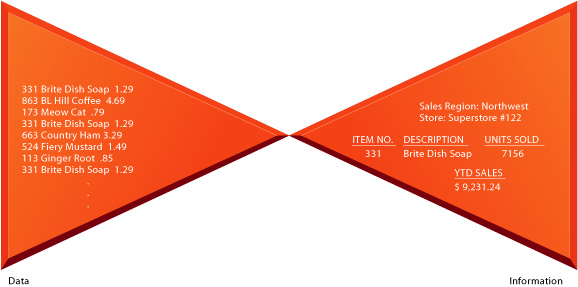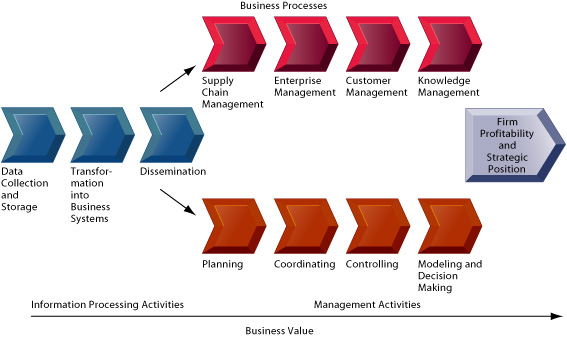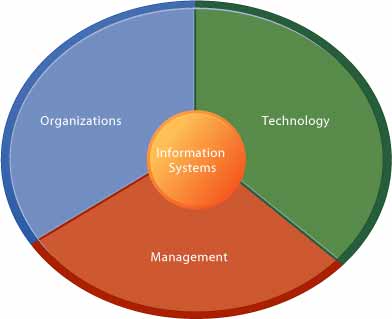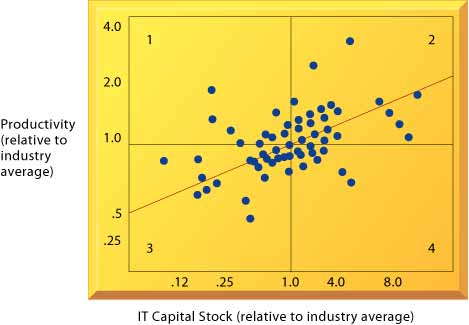| Section 1.2: Bullet Text |
Chapter
Contents | View
Full Text | View Bullet Text
|
Perspectives on Information Systems
An
information system
is a set of interrelated components that collect or retrieve, process,
store, and distribute information to support decision-making and control
in an organization. Information systems can also be used to analyze problems,
visualize complex subjects, and create new products.
Information
is data, or raw facts,
shaped into useful form for humans. [Figure 1-5]
 |
FIGURE 1-5
Data and information Raw data from a supermarket checkout counter can be processed and organized to produce meaningful information such as the total unit sales of dish detergent or the total sales revenue from dish detergent for a specific store or sales territory. |
Computer-based information systems (CBIS) are structured information systems that rely on computer hardware and software technology. Information systems are employed to support decision making and control in an organization.
Input, processing, and output are the three activities in an information system that produce the information an organization needs. Feedback is output returned to the various members of the organization to refine or correct input. [Figure 1-6]
 |
FIGURE 1-6
Functions of an information system
An information system contains information about an organization and its surrounding environment. Three basic activities—input, processing, and output—produce the information organizations need. Feedback is output returned to appropriate people or activities in the organization to evaluate and refine the input. Environmental factors such as customers, suppliers, competitors, stockholders, and regulatory agencies interact with the organization and its information systems. |
From a business perspective, an information system may be important for increased productivity or increased revenue, for coping with governmental regulations or other environmental demands, or simply for remaining competitive within the industry.
Information systems can also lead to better management decisions, more efficient business processes, and higher firm profitability. Every business has an information value chain in which raw information is acquired and systematically transformed through various stages that add value to that information. [Figure 1-7]
 |
FIGURE 1-7
The business information value chain
From a business perspective, information systems are part of a series of value-adding activities for acquiring, transforming, and distributing information that managers can use to improve decision making, enhance organizational performance, and, ultimately, increase firm profitability. |
An information system also represents an organizational and management solution, based on information technology, to a challenge posed by the environment.
Information systems literacy, the understanding of information systems, includes the understanding of the broader organization, management, and information technology dimension of systems and their power to provide solutions. [Figure 1-8]
 |
FIGURE 1-8
Information systems are more than computers
Using information systems effectively requires an understanding of the organization, management, and information technology shaping the systems. An information system creates value for the firm as an organizational and management solution to challenges posed by the environment. |
The key elements of an organization are its people, structure, operating system, politics and culture. An organization coordinates work through a structured hierarchy and formal, standard operating procedures. Managerial, professional, and technical employees form the upper levels of the organization's hierarchy while lower levels consist of operational personnel.
Knowledge workers such as engineers and scientists design products and create and distribute new knowledge for the organization. Data workers such as secretaries process the organization's paperwork. Production or service workers produce the products or services.
Different levels of management have different information needs. Senior managers need information for long-range strategic decisions. Middle managers need information for carrying out the plans of senior management. Operational managers need information to monitor the firm's daily activities.
Computer-based information systems use computer hardware, computer software, storage technology, and communications technology. These technologies constitute the firm’s information technology (IT) infrastructure.
Information technology investments cannot make organizations and managers more effective unless they are accompanied by complementary assets: supportive values, structures, and behavior in the organization and management. Investments in organizations and management that allow a firm to realize value from technology investments are called organizational and management capital. [Figure 1-9]
 |
FIGURE 1-9 Variation
in returns on information technology investment Although, on average, investments in information technology produce returns far above those returned by other investments, there is considerable variation across firms. Source: Based on Brynjolfsson and Hitt (2000). |